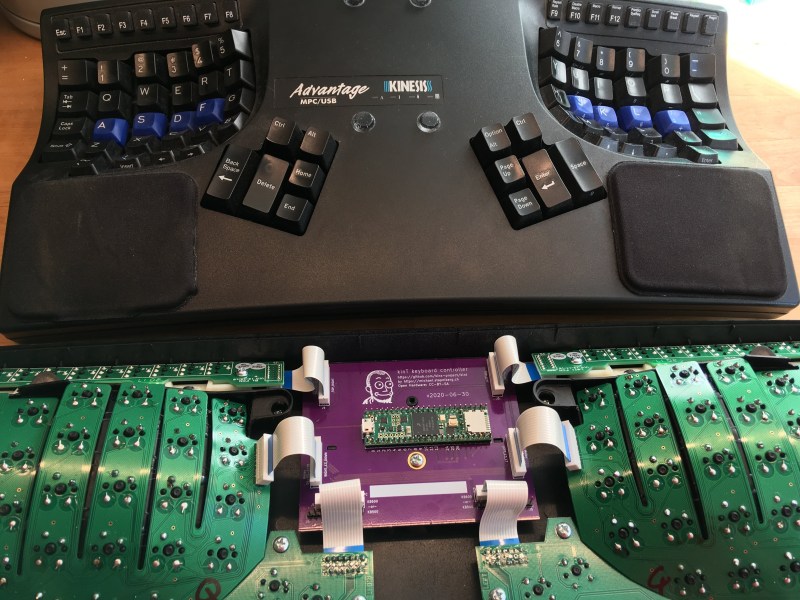Back in 2013, [Michael Stapelberg] created what is lovingly referred to as the Stapelberg controller: a replacement keyboard controller for the original Kinesis Advantage, the decades-old darling of the ergonomic clacking world. Whether you’re building a new keeb, you’ve got a broken Kinesis, or you simply want to run QMK on the thing and don’t mind getting your hands dirty, there’s a new Stapelberg controller on the block. It’s called the kinT, for Kinesis + Teensy.
[Michael] built kinT in response to the Advantage 2, which came along in 2017 and changed the way the thumb clusters connect to the main board from a soldered cable to an FPC connector. Whereas the original Stapelberg controller was built in Eagle, this one was done in KiCad and is open-source, along with the firmware. You can use a Teensy 4 with this board but if you don’t have one, don’t worry — kinT is backwards-compatible with pretty much every Teensy, and it will even work on the original Advantage.
Are you on the fence about going full ergo? Check out my in-depth review of the original Kinesis Advantage I got that’s almost 20 years old and still clacking along like new. But don’t wait for a repetitive stress injury to go full ergo. Trust me.
















There are a handful really cool bluetooth mods for the advantage similar to this one as well.
I never realised that they used what looks like a regular PCB for these things! I’d always assumed it was a flexible board or something similar, but on reflection, that would be way higher-tech than required.
Now I’m just going to go and see how much flex I can get out of my current keyboard PCBs…
Haven’t read the whole thing but I guess they at least used the thinner 1.2mm board? 1.6mm PCB doesn’t want to flex that much I think, OR it’ll pull quite hard on the switch pins…
I’ll guess that they use a multilayer PC board with custom lamination dies to form the curved PCBs. Or possibly heat to form them after manufacturing.
I can definitely tell you that those boards in the key wells are flex pcbs. They are just green.
It’s actually just 0.6 or 0.8mm pcb.
Poor Teensy. It´s a quite powerful 20USD SoC (the Teensy 4.0 clocks at 0.6GHz, and has a whooping 1MB of RAM) yet in 95% of the use cases featured on this website, it stands as USB HID controller.
… Like using a racing car to cross the lawn to pick up your mail. what a waste.
And also a powerful potential security threat. With that power you can brute-force passwords for days, staying unnoticed from the OS.
Nothing unusual in that – lots of commercial products have FPGA and/or microprocessors in them way overkill for what is required. For pretty much the same reasons a teensy is beloved by folks here – its easy to make it work, and the part is available for a reasonable price. Maybe if demand or upfront budget is high enough you spend the R&D time to make the product that penny cheaper to make, knowing you will get it back later, but for many things that doesn’t happen. And in some cases its overspec because they intend to, or know they will be pushing software updates with new features that need more horsepower.
I feel blessed to have cheap, easy USB chips. Git r dun
Why brute force? It is a keyboard, just key log.
That can be done with far weaker hardware, thus using weaker hardware does not change much, and we need a different approach anyway concerning security.
I have some ancient Kinesis sitting in my keyboard box here. (I think it came with an AT connector but I swapped that somewhat crudely for PS2) All the plastic stems need lubrication because they just jam if hit at not quite the right angle, which makes it hard to learn that more unique layout. I’ll have to look into this, see if it works for my version, might be a nice alternative to my usual Pro Micro TMK-based PS2 to USB converter.
On the “customer service” front, while it was too ancient to have the manual online, they did happily find and send me PDFs of the manual when I emailed them. Not too shabby, especially for a decades old find from University surplus.